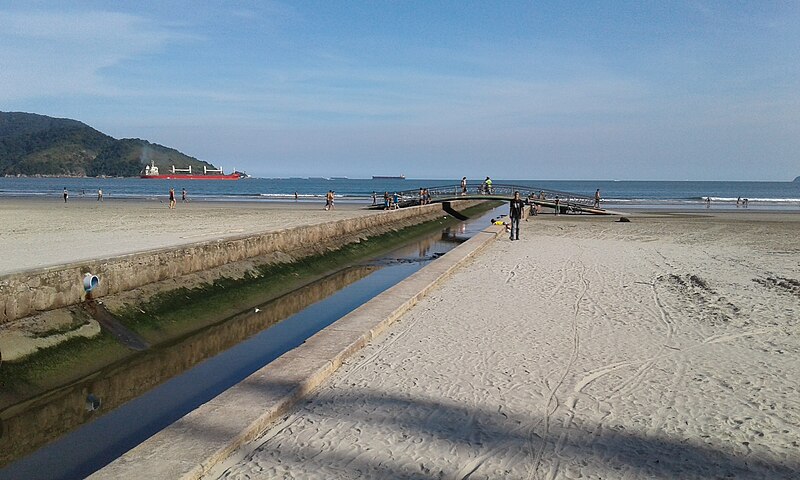Ciro Santilli lived in Santos from about the year 1998 to 2007, with a 10 month hiatus in Coventry, UK, until he went to the University of São Paulo.
Santos is the nearest beach city to São Paulo City, and for this reason:
- the largest port of Latin America in 2018, through which large chunks of the precious coffee export exited Brazil in the 19th century. There is a Coffee museum in Santos.This importance is also linked to the fact that Santos is one of the oldest european cities in Brazil, being founded in 1546. From this you can infer that it was a good port. One reason for this is obvious if you look at the map of the city: the neighbouring towns of Praia Grande and Guarujá form a large protected bay where ships may safely dock.
- a popular local tourist destination that gets crowded on hot weekends, with the beach line being fully built with tall buildings from the 60's, many of which became incredibly bent due to the inadequate technology used on such soft soil
Ciro idolizes Santos as the perfect location to live nature-wise due to its amazing wide sandy beach, in which Ciro spent endless hours walking on the sand and on the largest beachfront garden in the world (archive), meditating, and playing some soccer after school was over. Santos is also the city where Pelé first played professionally.
Ciro has visited Santos several times after leaving Brazil. Doing this gives him a weird feeling of having a separate life, in which time passes 2 weeks every few years. Of course, as your family grows, it gets harder and harder to go back home, and your family members might want to just go travel to more interesting places than just stay at your wonderful beach which you love in part due to nostalgia.
Ciro is also fond of the concept of the small public buildings near the beach garden (postos de praia), which serve different cultural activities: library, comic book store, art cinema, surf school. It is such a shame that the library and comic book ones are in such bad shape as of 2020, old books and poor people who go there to sleep a bit in the barely working air conditioning. Ciro fantasizes how those could instead be cultural hubs for the gathering of the brightest artists, and scientists, of town. Maybe they are just too small. Maybe it is not within the realm of possibility of public service. Maybe, we should focus instead in the poorer regions, far form the beach. But the dream remains.
Santos only has one natural defect: mosquitoes. By the sea it is fine because the wind is strong, and they don't like salt water. But anywhere else, you will be eaten alive, and maybe get dengue, Ciro got it once. Gene drive, please.
This instagram page has several drone videos of the region: www.instagram.com/malta.drone
Canal 5 on the beach by VicTrindade (2017)
Source. This is one of Santos 7 old canals, which are still in use and serve to reduce floodings in the city, which are caused by the strong tropical rains that fall on the city. This is particularly important to keep the mosquito population under some control. All canals were built in the first third of the 20th century, except canal 7 which is from 1968[ref]. The canals have normally very shallow water when it is not raining, and since it is rain water they are basically clean. There are other canals which are/were used for sewage, but then are not open air. The canals now serve as handy reference points and practical avenues in town, as well as being surrounded with nice trees that provide shade and drop small inedible purple fruit that will stain your car for all eternity. They do scar the beach line a bit it must be said, but it's part of the charm of the city, and they serve as good reference points for runners. Ancestors
Incoming links
- Ciro Santilli's 10 month stay in Coventry, United Kingdom, in the year 2000
- Ciro Santilli's biography
- Ciro Santilli's cycling
- Ciro Santilli's musical education
- Ciro Santilli's sport practice
- Mamonas Assassinas
- São Paulo City
- The best Brazilian pop honorable mentions
- What poor countries have to do to get richer
 Ciro Santilli
Ciro Santilli OurBigBook.com
OurBigBook.com
